Why the bow goes to the arrow, what to do and how to avoid it
Onions are a vegetable that is used by all housewives, without exception. It is good both fresh, and is indispensable in the preparation of many dishes. Therefore, all gardeners who have their own plots always grow this crop and try to save the harvest as long as possible.
The agrotechnology of onions does not differ in any special techniques, this vegetable grows well, but sometimes there is such a problem as shooting. At the same time, the bulb stops growing, and a thick and hard arrow appears above the soil surface.
Why the bow goes into the arrow, why it is bad and what to do - we will tell further.
Why shooting is dangerous for a bow
The arrow is, in fact, the same peduncle in which new seeds will ripen over time. For many onion varieties, this is practically the only way to reproduce. Therefore, the arrow, as such, is a danger only for onions when the goal of the gardener is to obtain the onion.
Such arrows do not allow the bulbs to form and develop correctly. Even if it is possible to get a harvest, it will not be distinguished by good keeping quality (it will lie at most until the middle of winter), and it will also be an order of magnitude smaller than with normal development.
Why does the bow go to the arrow
Shooting, unfortunately, is not uncommon for this vegetable crop, it can be said that this is the main problem when growing onions. There are several reasons for this.
Seed storage errors
Shooting often occurs due to such errors. There are several of them.
- It is difficult to observe the temperature regime when storing onion sets. If suddenly the planting material is exposed to even slight negative temperatures, then it will simply freeze and lose its suitability for planting. If storage is carried out at above-zero temperatures, then growth processes begin to start in the bulb. If during storage the plant has passed the stage of natural vernalization, then it, planted in the soil in spring, will certainly go to the arrow. In addition, in the warmth, small bulbs breathe actively, so they dry out quickly. Dried bulbs will never germinate in soil. To avoid all this, you should store the onion sets at 0 degrees. Air humidity is also of great importance; it should not exceed 90% during storage of the seed. Otherwise, the seed will begin to germinate, and when it is planted in the ground, flower stalks will appear.
- Onion variety - it also depends to a large extent on whether the vegetable will go to the arrow or not. For planting, it is always better to choose varieties that are intended for planting in your region, that is, zoned. They will grow and store better. Keeping quality is determined by the color of the integumentary scales: the most lying onions have a golden color, red and white varieties do not have good keeping quality.
- Correct harvesting time for sevka. If you are late in harvesting the onions from the ground, then the young bulbs begin to prepare for wintering and grow their own roots. This indicates that there is a violation of the biological rhythm. Sevok will never survive under such circumstances.
- Storage of seedlings without preliminary sorting. If the total mass of planting material contains both too small and large bulbs, this is bad. Small ones will dry out, and large ones (1-3 cm) will remain excellent under the same conditions. Therefore, it is advisable to store bulbs of approximately the same size.In addition, during the wintering period, you need to get the onion sets several times and sort it out. This is necessary to discard rotten, dried out and moldy bulbs.
Sewing dimensions
Onion sets are always calibrated before being sold. It involves the separation of material into fractions:
- 8-14mm - These bulbs are the best option for planting in winter. Their main advantage is the absence of shooting. But there is also a risk - without any shelter, small winter seeding will freeze out. For spring planting, a small set is not suitable - it will grow for a long time and it will not be possible to get large, full-fledged bulbs. In this, the minimum supply of nutrients and a scanty amount of moisture in the upper soil layer will play a negative role (and a small seeding is embedded there).
- 14-21mm - the middle fraction is perfect for both winter planting and spring planting. If there is a goal to plant onions in the spring, then you need to buy such a fraction. The survival rate is excellent and at the same time shooting is excluded. Ripe bulbs turn out to be large, in this it plays a role in the fact that there was enough strength in the seed for growth.
- 21-24mm - coarse fraction. If such a set is planted in winter, then it is advisable to do this only to obtain greenery. With excellent survival rate in the soil, shooters cannot be ruled out. The risk increases if you plant too early. But if you remove the arrows in time, you get a good harvest.
- 24-30mm - the coarse fraction is used exclusively for the production of greens. Hence the cost - it is much lower than the cost of all previous factions. Such sevok sits on greens both in autumn and spring.
- 30-40mm - onions are planted only to get greens.
In addition to size, it is important to pay attention to the following points when buying a set:
- Onions should not emit foreign odors (mold, rot, etc.).
- The color should be even, without whitish spots.
- The sevok should be dry, without roots and green shoots.
Landing dates
Violation of planting dates is considered to be one of the main reasons for bow shooting. However, there are no exact landing dates. Even in one region, the landing dates can significantly shift in one direction or another, depending on weather conditions.
Therefore, the only way to determine that it is time to plant sevok - this is the degree of warming up of the earth. When it is already warm enough, start planting. If planted early and in cold soil, the bow will go into the arrow.
If planted late, there will be no full-fledged bulbs. Onion sets less than 3 cm in size must be planted from the last days of April. If you plant winter onions, the risk of arrowheads is reduced.
But such a landing is possible only in those places where there are moderate climatic conditions. In regions where severe winters prevail, winter planting is not suitable: shooting will become a kind of protective reaction to freezing of the root system during wintering.
Lack of moisture during the growing season is also one of the reasons for shooting, although less common. Also, one of the reasons is an excess of nitrogen in the soil.
Why does the bow go to the arrow and turn yellow
If everything is more or less clear with arrowing, then sometimes another problem arises - the onion begins to turn yellow right in the beds. There are several reasons for this phenomenon:
- Insufficient watering. With the onset of hot days, at the beginning of summer, you need to water the onions at least 2 times a week. Gradually, the number of waterings can be reduced to once a week (in the second half of summer). When a persistent drought sets in, watering should be more frequent and more abundant. Water the onion under the root, preferably in the morning.
- Lack of micro and macro elements in the soil, nitrogen. If this is the case, then the feather of the onion will be short, thick and yellowish in color. To avoid such an effect, nitrogen-containing or organic fertilizers must be added to the onion beds.
- Damage by pests.Here, only the processing of the sevka before planting (in cases with stem nematode), treatment with insecticides (from onion moth, onion fly, onion thrips) will help.
- Onion diseases. It is necessary to process the soil before planting, remove poor-quality bulbs before planting, if diseased plants appear, burn them.
What to do to prevent the bow from shooting
In order to prevent the development of unnecessary peduncles, the rules must be followed.
Elimination of the listed errors
First of all, you need to properly store the onion sets in compliance with the recommended temperature and humidity. In addition, you need to choose a set size that matches the ultimate goal of planting onions. If this is the production of turnip onions, then the bulbs of the middle fraction are selected. Larger (cheaper) options are also suitable for the pen. In addition, it is important to comply with the planting dates - this should be done only when the ground becomes warm enough.
Processing before planting
Preplanting onion sets is just as important. Such processing is necessary for self-grown and preserved seedlings. The one that was bought in the company store has probably already gone through the processing process. There are several ways to prepare a set for planting:
- Soaking in salt. This technique will accelerate germination, increase resistance to diseases, pests and adverse weather conditions. For 1 liter of water, take 20-30 g of salt and soak the sevok in this solution for 3-4 hours. Dry the onions before planting.
- Warming up the set is a method of preventing shooting. You can spread the newspaper in a hot place at home, in front of the window and sprinkle onion sets prepared for planting on it. You can simply lay the corrugated paper on the battery and dry like this. Two weeks warming up is carried out at +20 degrees, then two more - at +40 degrees.
- Hardening - such a measure will develop the resistance of the seedlings to spring temperature fluctuations. To do this, prepare two containers of water. One is filled with water with a water temperature of +45 degrees, the onion is placed on it for 15 minutes. After that, the set is transferred to a container with cold water for 10 minutes. After thoroughly drying, the seeds are ready to be planted in the soil.
Non-shooting varieties
- Troy is an early maturing set. The bulbs are round - light to dark golden in color. The taste is moderately spicy. Excellent keeping quality, can be stored up to 4 months. They are planted both in winter and in spring. Shooting resistance - extremely high.
- Radar is a hybrid from Holland. Sits down in the winter. The shape is flat-round, the color of the scales is yellow, the taste is pronounced spicy. Bulbs grow large - up to 300 g. High resistance to shooting.
- Senshui yellow is the work of breeders in Japan. It also sits down in the winter. It has a flat shape, rich yellow color and a pungent taste. Resistant not only to shooting, but also to powdery mildew.
What to do if the bow has already fired arrows
If a onion has already released the arrows, they must be removed immediately, and as soon as possible. Do not forget that the arrow always takes nutrients from the bulbs. If the first arrows are seen on the onion bed, you need to increase watering.
How you can use arrows
Onion arrows do not need to be thrown away, of course. They are perfect for preparing vegetable dishes such as vegetable stew, French ratatouille, salads, pies and others. You can dry onion arrows for the winter.
Tips from experienced summer residents
- When choosing a planting time, you need to focus on birch buds. When they have already burst and the leaves have appeared, it means that the earth is already warm enough and you can plant sevok.
- Intensive watering is needed only before the formation of bulbs (this is approximately mid-June).
- Shooting is mostly due to improper storage. It is necessary to warm up and harden the sets. Before planting, you can hold the set in +60 degrees water. If arrows appear, they must be cut off.
Watch the related video:



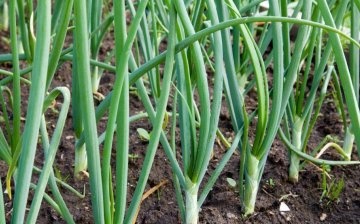
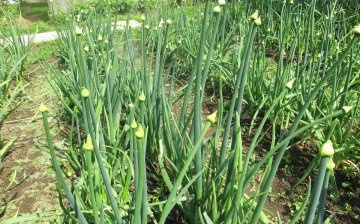
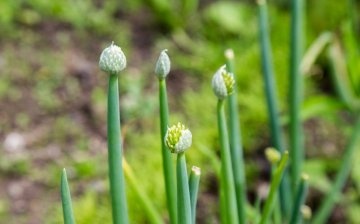



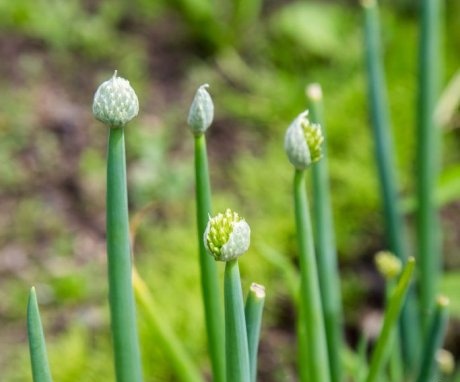
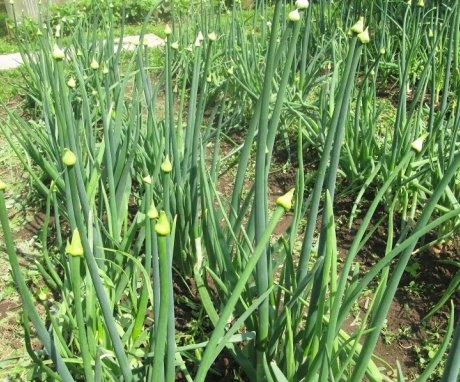
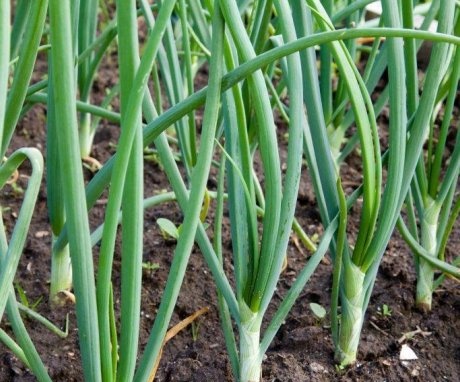
We have some bow that also goes into the arrow. I noticed that - it depends on the size of the set. The larger it is, the higher the likelihood that the bow will go into the arrow. Next year, I will experiment with onions.
I never managed to save the sets on my own - I always buy on the market and don't think about additional processing. But I always remove the arrows, but next year I want to plant the Radar variety. I wonder how it will grow when planted in winter.
We call these "arrows" "pipes", if you cut them and fry them in vegetable oil, it turns out very tasty and unusual, try it, I think you will also like this simple dish.
We call these "arrows" "pipes", if you cut them and fry them in vegetable oil, it turns out very tasty and unusual, try it, I think you will also like this simple dish.